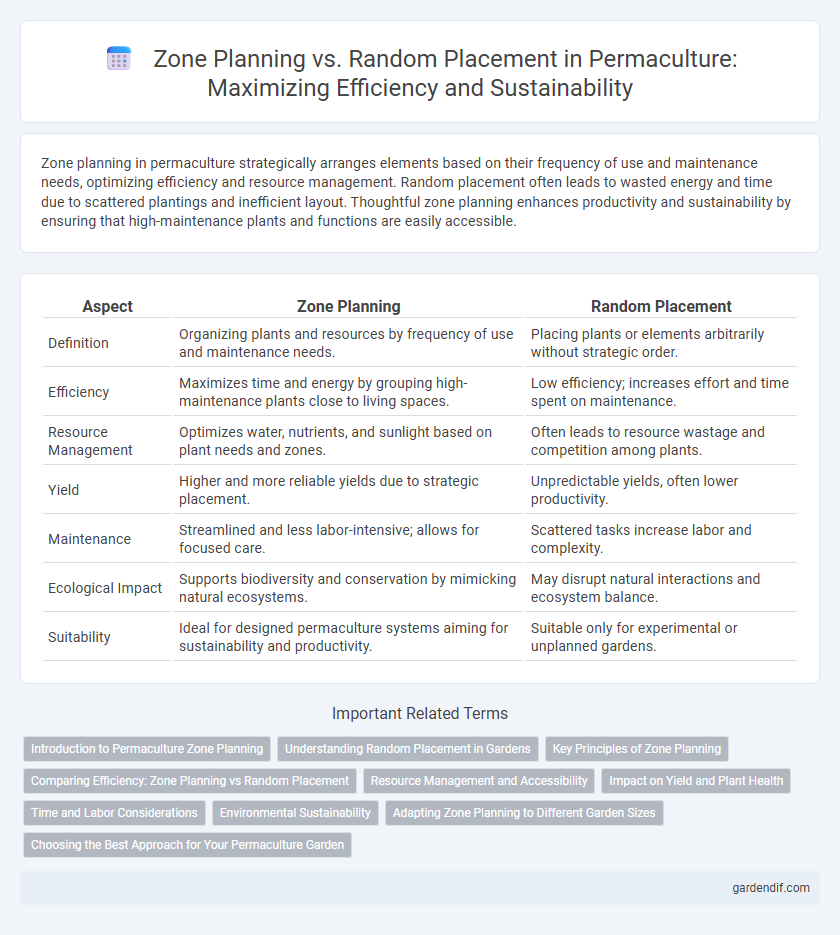
Zone Planning vs Random Placement Illustration
Zone planning in permaculture strategically arranges elements based on their frequency of use and maintenance needs, optimizing efficiency and resource management. Random placement often leads to wasted energy and time due to scattered plantings and inefficient layout. Thoughtful zone planning enhances productivity and sustainability by ensuring that high-maintenance plants and functions are easily accessible.
Table of Comparison
| Aspect | Zone Planning | Random Placement |
|---|---|---|
| Definition | Organizing plants and resources by frequency of use and maintenance needs. | Placing plants or elements arbitrarily without strategic order. |
| Efficiency | Maximizes time and energy by grouping high-maintenance plants close to living spaces. | Low efficiency; increases effort and time spent on maintenance. |
| Resource Management | Optimizes water, nutrients, and sunlight based on plant needs and zones. | Often leads to resource wastage and competition among plants. |
| Yield | Higher and more reliable yields due to strategic placement. | Unpredictable yields, often lower productivity. |
| Maintenance | Streamlined and less labor-intensive; allows for focused care. | Scattered tasks increase labor and complexity. |
| Ecological Impact | Supports biodiversity and conservation by mimicking natural ecosystems. | May disrupt natural interactions and ecosystem balance. |
| Suitability | Ideal for designed permaculture systems aiming for sustainability and productivity. | Suitable only for experimental or unplanned gardens. |
Introduction to Permaculture Zone Planning
Permaculture Zone Planning organizes landscapes into distinct zones from 0 to 5 based on frequency of human interaction and plant needs, maximizing resource efficiency and minimizing labor. This method contrasts with random placement by strategically positioning elements like herb gardens in Zone 1 for daily use and orchards in Zone 3 for seasonal care. Implementing Zone Planning enhances sustainability, energy conservation, and ecosystem balance, crucial for productive permaculture design.
Understanding Random Placement in Gardens
Random placement in gardens involves distributing plants without a predetermined pattern, which can promote biodiversity and mimic natural ecosystems. Unlike zone planning that prioritizes efficiency and accessibility by grouping plants based on their maintenance needs and functions, random placement encourages a more organic growth pattern, fostering resilient microclimates and beneficial insect habitats. This approach can enhance soil health and reduce pest outbreaks by avoiding monoculture-like conditions typical of rigid garden layouts.
Key Principles of Zone Planning
Zone planning in permaculture emphasizes the strategic arrangement of elements based on frequency of use and maintenance needs, contrasting with random placement that often leads to inefficiency. Key principles include placing high-maintenance plants and tools closer to the dwelling to minimize labor and energy while locating less frequently attended areas like orchards and woodlots farther away. This approach optimizes resource flow, reduces waste, and enhances ecosystem integration, promoting sustainable and productive land use.
Comparing Efficiency: Zone Planning vs Random Placement
Zone planning in permaculture enhances energy efficiency by systematically arranging plants and resources according to their frequency of use, minimizing labor and resource waste. Random placement often results in increased time and effort due to inefficient access and care patterns, reducing overall productivity. Optimizing garden layout through zone planning supports sustainable management and maximizes yield per area.
Resource Management and Accessibility
Zone planning in permaculture enhances resource management and accessibility by strategically organizing plants and structures based on frequency of use and maintenance needs, reducing energy expenditure and maximizing productivity. Random placement disregards these principles, often leading to inefficient water usage, increased labor, and difficulty accessing essential resources. Optimizing zones ensures sustainable energy flow and fosters harmonious interactions among ecosystem components.
Impact on Yield and Plant Health
Zone planning in permaculture organizes plants based on their frequency of use and care needs, enhancing yield by optimizing access to sunlight, water, and nutrients, resulting in healthier plants. Random placement often leads to inefficient resource utilization, increased competition for light and soil nutrients, and compromised plant health, reducing overall productivity. Careful zoning minimizes stress on plants and supports diverse microclimates, directly improving crop resilience and yield stability.
Time and Labor Considerations
Zone planning in permaculture optimizes time and labor by grouping plants and elements based on their frequency of use and maintenance needs, reducing unnecessary movement and effort. Random placement often leads to increased labor, as resources and attention are spread inefficiently across the site. Careful zone design ensures that high-maintenance plants reside close to living areas, streamlining daily care and overall garden management.
Environmental Sustainability
Zone planning in permaculture enhances environmental sustainability by strategically placing elements based on their frequency of use and energy needs, minimizing resource waste and reducing environmental impact. Random placement often leads to inefficient energy flows and increased resource consumption, which can degrade soil health and biodiversity. Structured zoning supports ecosystem balance, promotes efficient water use, and fosters resilient microclimates essential for sustainable agricultural systems.
Adapting Zone Planning to Different Garden Sizes
Zone planning in permaculture optimizes energy use by organizing plants and elements based on frequency of use and maintenance, making it adaptable to various garden sizes. Smaller gardens benefit from closely grouping high-maintenance zones near living spaces, while larger gardens can expand lower-maintenance zones further away to maximize efficiency. Customizing zone layouts according to garden size enhances sustainability and productivity by minimizing resource input and labor.
Choosing the Best Approach for Your Permaculture Garden
Zone planning in permaculture organizes plants and elements based on their frequency of use and maintenance needs, maximizing efficiency and minimizing energy expenditure. Random placement may offer aesthetic variety but often leads to increased labor and resource waste. Opting for zone planning enhances productivity and sustainability by aligning design with natural patterns and gardener habits.
Zone Planning vs Random Placement Infographic

 gardendif.com
gardendif.com